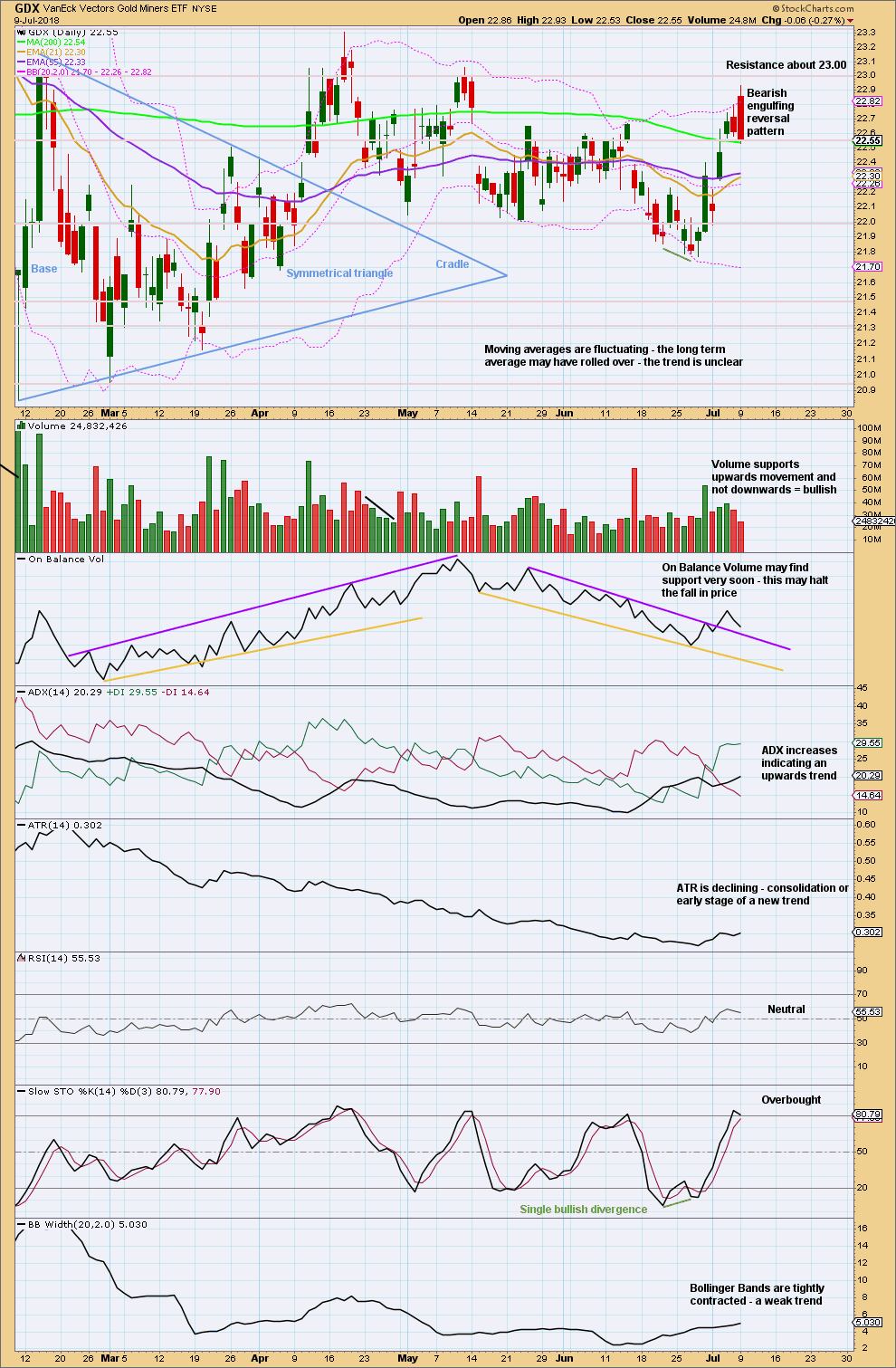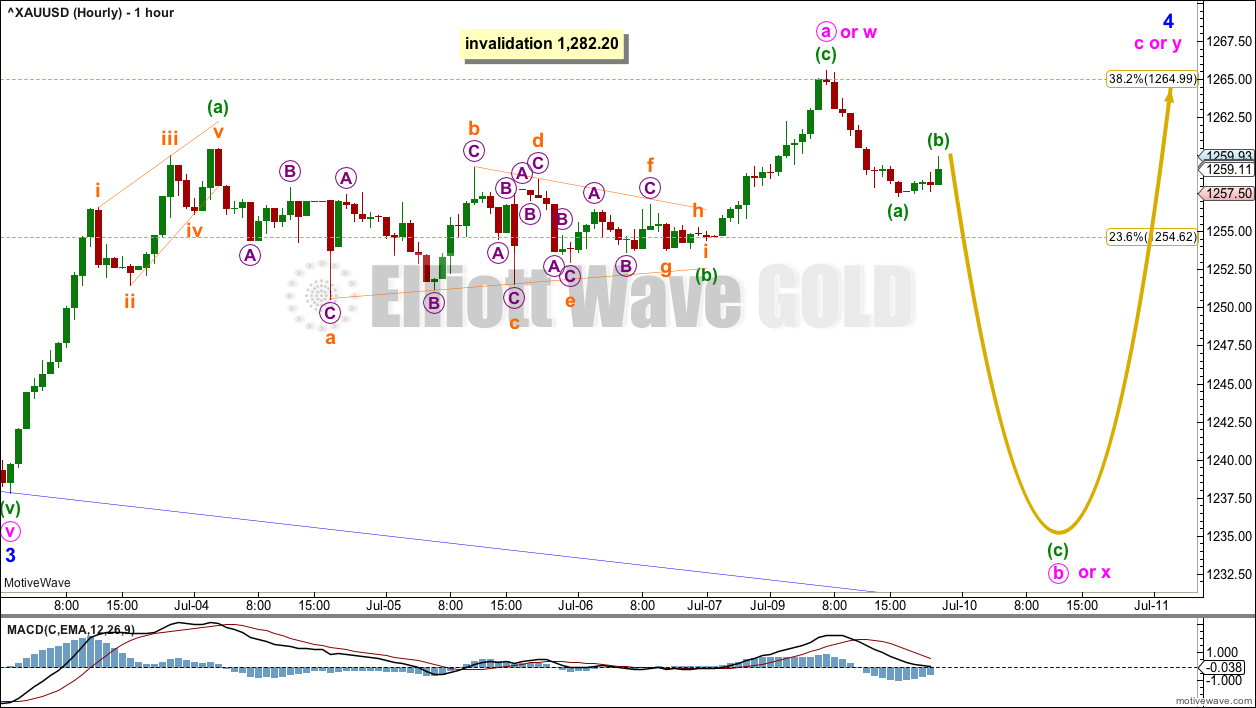A small upwards day to just above 1,265 fits expectations for the short term. 1,265 was expected to be about where upwards movement may find resistance.
Summary: A multi day to multi week consolidation looks likely to have begun here. It may be a sideways consolidation to last one to two weeks, remaining below 1,282.20. At this stage, it may be only about one third complete. Look now for a downwards swing to support.
When the consolidation is complete, then a final wave down to a final low is expected. The mid term target is 1,216 – 1,211. Downwards movement may be limited to no lower than 1,123.08.
Always trade with stops to protect your account. Risk only 1-5% of equity on any one trade.
At the end of this week, it may be a good idea to note that neither Gold nor Silver have made new swing lows below the prior major swing lows of December 2017. They have both come very close this week, but have both failed by a small margin. This must be interpreted as bullish, until proven otherwise.
New updates to this analysis are in bold.
Grand SuperCycle analysis is here.
Last historic analysis with monthly charts and several weekly alternates is here, video is here.
There are six weekly charts published in the last historic analysis. All but two expect more downwards movement at this time; the two bullish wave counts would be invalidated below 1,236.54. Because the remaining four bearish wave counts all expect the same movement next only one shall be published on a daily basis. Members should keep the other wave counts in mind. They will be published on a daily basis if they begin to diverge from the triangle wave count.
MAIN ELLIOTT WAVE COUNT
WEEKLY CHART – TRIANGLE
The triangle so far has the best fit and look. If price shows a combination or flat may be more likely, then those ideas may be published on a daily basis. The flat and combination ideas expect movement reasonably below 1,123.08, or perhaps a new low below 1,046.27.
Cycle wave b may be an incomplete triangle. The triangle may be a contracting or barrier triangle, with a contracting triangle looking much more likely because the A-C trend line does not have a strong slope. A contracting triangle could see the B-D trend line have a stronger slope, so that the triangle trend lines converge at a reasonable rate. A barrier triangle would have a B-D trend line that would be essentially flat, and the triangle trend lines would barely converge.
Within a contracting triangle, primary wave D may not move beyond the end of primary wave B below 1,123.08. Within a barrier triangle, primary wave D may end about the same level as primary wave B at 1,123.08, so that the B-D trend line is essentially flat. Only a new low reasonably below 1,123.08 would invalidate the triangle.
Within both a contracting and barrier triangle, primary wave E may not move beyond the end of primary wave C above 1,365.68.
Four of the five sub-waves of a triangle must be zigzags, with only one sub-wave allowed to be a multiple zigzag. Primary wave C is the most common sub-wave to subdivide as a multiple, and this is how primary wave C for this example fits best.
Primary wave D must be a single structure, most likely a zigzag.
One triangle sub-wave tends to be close to 0.618 the length of its predecessor; this gives a target for primary wave D.
There are no problems in terms of subdivisions or rare structures for this wave count. It has an excellent fit and so far a typical look.
DAILY CHART – TRIANGLE
Primary wave D may be unfolding lower as a single zigzag, and within it intermediate waves (A) and (B) may be complete.
The target is widened to a $5 zone calculated at two degrees. This should have a reasonable probability.
Within intermediate wave (C), it looks likely that all of minor waves 1, 2 and 3 may now be over. Minor wave 4 may have begun.
Minor wave 2 fits as a double zigzag, and was shallow. Given the guideline of alternation, minor wave 4 may most likely be a flat, combination or triangle; it may be very shallow, but more likely it may be deep in order to exhibit alternation with minor wave 2.
Minor wave 2 lasted 18 days, and it shows up on the weekly chart. Fourth waves for Gold are often quicker than second waves; minor wave 4 may last about one or two weeks.
Minor wave 4 may not move into minor wave 1 price territory above 1,282.20.
Adjust the channel to fit as an Elliott channel drawn using Elliott’s first technique. If it is long lasting enough, then minor wave 4 may find resistance about the upper edge of this channel.
HOURLY CHART
The first wave of all of a flat, combination or triangle must subdivide as a three. It is most commonly a zigzag.
A zigzag upwards may now be complete, which may be minute wave a of a flat or triangle, or minute wave w of a combination.
A downwards swing for minute wave b or x may now be expected.
If minor wave 4 is unfolding as a flat correction, then within it minute wave b must now retrace a minimum 0.9 length of minute wave a at 1,240.60. The common range for minute wave b within a flat correction would be from 1 to 1.38 times the length of minute wave a, giving a range from 1,237.82 to 1,227.26.
If minor wave 4 is unfolding as a triangle, then within it minute wave b must now unfold lower as a corrective structure, most likely a zigzag. There is no minimum nor maximum length for minute wave b within a triangle, and it may make a new low below the start of minute wave a at 1,237.82 as in a running triangle.
If minor wave 4 is unfolding as a combination, then within it the first structure in the double may now be a complete zigzag labelled minute wave w. The double should now be joined by a three unfolding in the opposite direction labelled minute wave x. Minute wave x may be any corrective structure, and there is no minimum nor maximum required length for it.
TECHNICAL ANALYSIS
WEEKLY CHART

Click chart to enlarge. Chart courtesy of StockCharts.com.
On Balance Volume has made a new swing low below the prior swing low, but price has not. On Balance Volume should be read as a leading indicator, so this is bearish and indicates price may likely follow through with a new swing low below 1,238.30.
The last weekly candlestick is bullish, and a short term bullish view has support from single week divergence between price and On Balance Volume, Stochastics and RSI; price made a new low last week, but none of On Balance Volume, Stochastics or RSI made new lows as they all moved higher.
DAILY CHART

Click chart to enlarge. Chart courtesy of StockCharts.com.
The short term volume profile remains bullish, but the long upper wick today is fairly bearish. This supports the hourly Elliott wave count.
GDX WEEKLY CHART

Click chart to enlarge. Chart courtesy of StockCharts.com.
Support about 20.80 has been tested about eight times and so far has held. The more often a support area is tested and holds, the more technical significance it has.
In the first instance, expect this area to continue to provide support. Only a strong downwards day, closing below support and preferably with some increase in volume, would constitute a downwards breakout from the consolidation that GDX has been in for a year now.
Resistance is about 25.50. Only a strong upwards day, closing above resistance and with support from volume, would constitute an upwards breakout.
The last upwards week lacks support from volume.
GDX DAILY CHART

Click chart to enlarge. Chart courtesy of StockCharts.com.
Give weight to the Bearish Engulfing candlestick pattern today. It looks like the upwards swing may now be over. Look for a trend change to either down or sideways.
Published @ 10:41 p.m. EST.




Updated hourly chart:
a double zigzag may be unfolding down for minute b or x. the structure is incomplete.